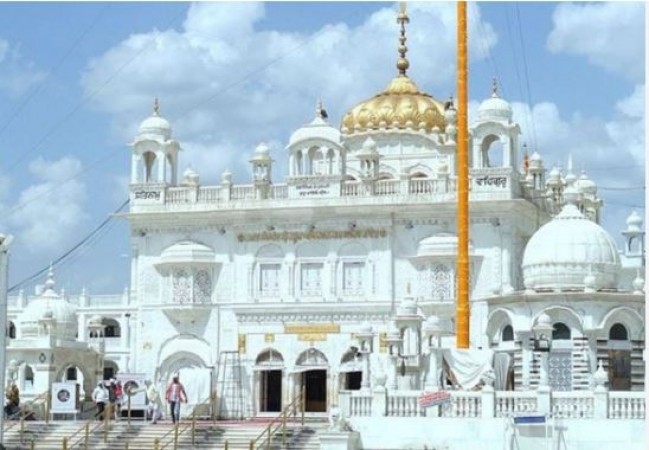
Hazur Sahib also known as Takht Sachkhand Sri Hazur Sahib is one of the five Takhts in Sikhism. Huzur Sahib is a title of reverence meaning ‘Exalted Presence’.
Takht Sachkhand Sri Hazur is situated on the bank of the Godavari River in Maharashtra. This is the place where Sri Guru Gobind Singh re-joined with God and commanded Sikhs to follow the Guru Granth Sahib as the Guru.
Sachkand means the region of truth was used as a word by Guru Nanak Dev Ji to mean the abode of God. Maharaja Ranjit Singh (1780–1839), who gave the order, had the gurdwara constructed between 1832 and 1837. A two-story gurdwara with a golden dome was erected there by Maharaja Ranjit Singh Sher-e-Panjab. During this period, a huge number of Sikh craftspeople and laborers arrived in Nanded.
Also Read:Gurudwara Bangla Sahib: Raja Jai Singh Bungalow To Shrine
The Muslim ruler of the Deccan, the Nizam of Hyderabad State, created a group of Northern Sikhs to serve his army around the same period. The majority of these individuals made Hyderabad State their permanent home, and in the 19th century, many militant and pious Deccan Hindus converted to Sikhism. The Guru Gobind Singh and gurdwara are highly revered by the local Hindus as well.
The gurdwara's current structure was built by Gulab Singh of New Delhi. It was finished on April 13th, 1968. The Guru Granth Sahib is installed on a canopied throne made of white marble in the main hall.
At the time of Emperor Bahadur Shah's march towards the south via Rajputana, Guru Gobind Singh accompanied him with his disciples and followers. Crossing the Tapti in mid-June and Ban Ganga on 13 August, the two camps arrived at Nanded towards the end of August 1708.
Also Read:Hemkund Sahib: Highest Gurudwara In World
Bahadur Shah, after a brief halt, crossed the Godavari and proceeded on to Golkonda, but the Guru stayed behind at Nanded. Here he converted a Vaishnavite Bairagi recluse, Madho Das, also known as Lachman Dev, who after initiation into the Khalsa fold, received the name of Banda Singh.
Two Pathans traveled from Punjab to Nanded in search of Guru Gobind Singh. Wazir Khan of Sirhind, who felt threatened by the amicable talks taking place between the Emperor and Guru Gobind Singh, had recruited them. These Pathans, one of them is identified as Jamshaid Khan, began showing up for the evening diwan or service while pretending to be attentive listeners.
They discovered the Guru alone in his tent at night and threw themselves on him, stabbing him. The Guru dispatched one of the Pathans with his talwar before the blow could be repeated. The other attempted to flee but was slain by his supporters
The Guru had a serious wound, but it originally healed after a European surgeon patched it up. On October 7, 1708, Guru Gobind Singh re-joined with God after designating the Guru Granth Sahib as his successor and terminating the succession of personal Gurus. However, the wound reopened a few days later as the Guru was stringing a bow for one of his Sikhs.
Also Read:Gurudwara Takht Sri Harmandir Patna Sahib
One of Guru Gobind Singh's Sikhs, Santokh Singh, who oversaw the communal kitchen, was supposed to stay in Nanded and continue administering the Guru ka Langar. Other Sikhs also decided to remain behind.
The Guru Granth Sahib was placed on the platform that Guru Gobind Singh would have used to hold his court after the Sikhs erected a chamber above it. It was known as Takht Sahib. When bestowing guruship on the holy book, Guru Gobind Singh himself gave Nanded the name "Abchal nagar" based on the first word of a verse read at random at the time. Abchal and nagar are both Sanskrit terms for town or city respectively.
Also Read:Chaar Sahibzaade: Unforgettable Sacrifice
Hazur Sahib has one Bunga Mai Bhago a large room where tourists will find Guru Granth Sahib Ji and his possessions of Guru Gobind Singh Ji like a Brilliant knife, a matchlock rifle a bunch of 35 bolts two safeguards set with valuable stones, and five brilliant swords. The second room is Angitha Sahib built in 1708 where Guru Gobind Singh was cremated. Like Harmandir Sahib in Amritsar, Hazur Sahib also has gilded domes, and on the top is a Kalash of gilded copper.
Also Read:Gurudwara Sri Paonta Sahib